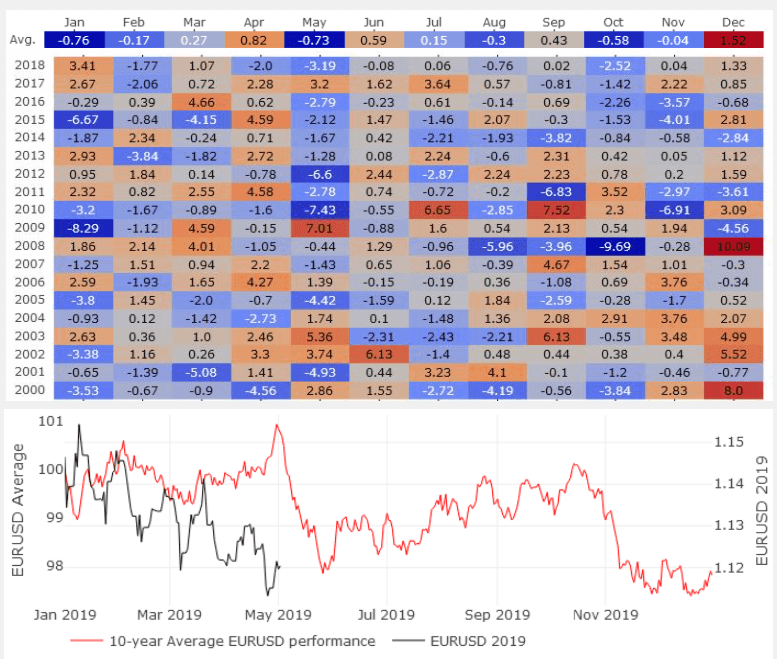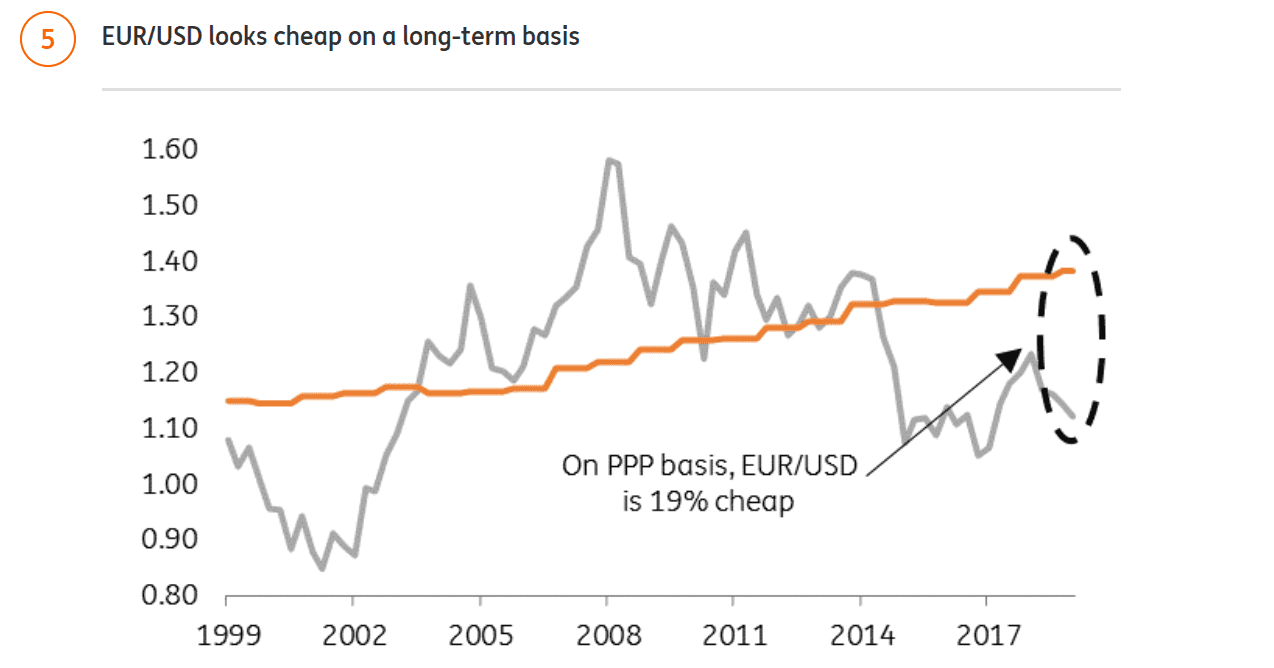The Euro Usually Falls in May, but 2019 Could be Different

Image © Andrey Popov, Adobe Stock
- EUR/USD normally falls in May
- But 2019 could see gains say MUFG
- ING see 5 reasons for a EUR/USD rise
- EU-US trade war unlikely says AMPCapital
The Euro tends to fall against the U.S. Dollar in May.
Data from the past 17 years shows the Euro-to-Dollar exchange rate tends to fall 0.73% in May, and over the course of the last 10 years the "phenomenon has become more pronounced," says Derek Halpenny with MUFG.
The EUR/USD has fallen in May in 8 of the past 10 years with an average decline of 1.7%. June meanwhile tends to be a good month for the Euro with EUR/USD delivering gains in the last 19 years; again the trend has become more pronounced in the past 10 years.
This month ought to be different, however, says Halpenny.
“Although the 'May effect' could hold up in the face of this week's FOMC meeting and US Dollar strength should continue into May, the Euro is already quite weak and Dodd-Frank Options Flow data recently indicated a more Euro-bullish sentiment says Halpenny.
ING: 5 Reasons to go 'Long' the Euro
A broader bullish outlook for the pair is put forward by Dutch bank ING, which is medium and long-term bullish EUR/USD, even though in the short-term they are bearish, seeing a risk of s decline to 1.10 before a recovery gets going.
“The recent fall below 1.12 has raised fears about another major leg lower in EUR/USD. We'd already penned a move to 1.10 in our profile for 2Q19 and we do acknowledge that the case for a rebound later this year has become a little harder. However, we think there are still 5 good reasons why EUR/USD will turn higher to 1.20 next year,” says Chris Turner global head of strategy and head of EMEA and LATAM research at ING.
ING forecasts a gentle rise in H2 to 1.15 by year-end, before the stronger surge in 2020 and give 5 reasons for expecting the pair to rise:
1. U.S. growth may be outperforming Eurozone now (3.2% vs 1.2%) but it is unsustainable and mainly due to inventory stockpiling and trade effects. ING expects U.S. growth to slide to below 2.0% by 2020. Their view of the Eurozone meanwhile is for it to continue in the 1.1-1.5% range for the next 6-8 quarters.
“The narrative of US macro outperformance should therefore fade. This should have important implications for international equity flows and EUR/USD,” say Turner and Krpata.
2. Differences in two countries interest rates often impact on currencies via foreign capital flows, which tend to prefer the destination with the higher interest rate outlook. Whilst this currently supports the U.S. and the Dollar, ING sees a risk U.S. interest rates will slide lower, whilst Eurozone rates - much like Eurozone growth - will remain the same. During the recalibration, the Dollar should lose ground.
3. As U.S. growth deteriorates it will get harder to fund its twin deficits (trade or current account and budget). It will have to look outside America for funding which will weigh on the U.S. Dollar.
"The Dollar’s backdraught from inflows of earnings repatriated abroad will also fade as this was a one-off due to the 2017 Tax Cut and Jobs Act. This prompted US companies to pay US$500bn more in dividends than a year earlier – ie, repatriating funds from overseas to distribute as dividends in the US,” says Turner.
4. In contrast to the U.S, the Eurozone’s balance of payments looks constructive for the Euro.
“Behind the scenes, the Eurozone BoP position has been improving markedly. The ECB’s crowding out (into foreign bond markets) of European investors has slowed dramatically, meaning that the Basic Balance (Current Account + Direct Investment + Portfolio Flows) is now more Euro supportive,” says Turner.
5. The Euro is undervalued by 19.0% based on purchasing power parity (PPP) basis. This is a model which generates a fair value based on the direct exchange of two baskets of identical products from the two different currencies’ jurisdictions.
Threat of Trump trade war with Europe overstated
One key risk on the Euro's horizon is the potential for a trade war between the U.S. and Europe.
In mid-February, the U.S. Commerce Department completed an investigation which according to media reports gave Trump the legal backing to impose heavy new tariffs on imported cars on national security grounds.
Trump had until mid-May to decide whether to go ahead with imposing tariffs on imported autos. Europe, along with Japan, would bear the brunt of those tariffs, and it was considered a key risk for the single currency.
Trump is not expected to go ahead with imposing tariffs, however, according to Dr. Shane Oliver, chief economist at asset manager AMPCapital.
“Ultimately, I don’t see Trump embarking on a full blown trade war with Europe, and there are several reasons why,” says Oliver.
According to Oliver, part of the incentive for Trump to wrap up a deal with China was to steady share markets and the economy prior to the elections in 2020, and last thing he would want is for the economy to take a hit from more trade mayhem.
There is little public transport in the U.S. limiting travel options. There is much less support for a trade war against China in Congress than against the EU.
The trade deficit between the U.S and Europe is a fraction of the size of the deficit it had with China, thus awarding less moral imperative to re-writing the perceived imbalance.
Time to move your money? Get 3-5% more currency than your bank would offer by using the services of foreign exchange specialists at RationalFX. A specialist broker can deliver you an exchange rate closer to the real market rate, thereby saving you substantial quantities of currency. Find out more here.
* Advertisement







